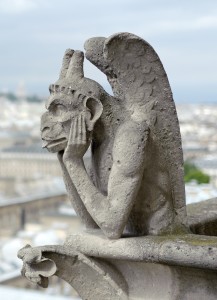
One of the icons of Paris and probably one of the first stops for a first-time visitor is Notre-Dame de Paris (Our Lady of Paris) or simply, Notre-Dame. It is located on the Île de la Cité, an island in the Seine, and the historic center of the city. What you see is a beautiful and clean gothic cathedral standing in this marvelous public square. The sun shines down on you and you can see both the Right and Left Banks on opposite sides of the Seine. You can move around relatively easily on either side of the ancient street that bisects the island from north to south: Boulevard du Justice. Prior to 1858, none of this was true.
Medieval Île de la Cité
During the time Notre-Dame was being constructed (1163–1345) the island was a maze of densely populated working-class houses, churches (twenty-seven of them), and narrow, muddy, winding streets. A new east-west road had to be built (c. 1160) to reach the front of Notre-Dame to allow for delivery of construction materials. It was the widest road in Paris at that time: 16 feet.
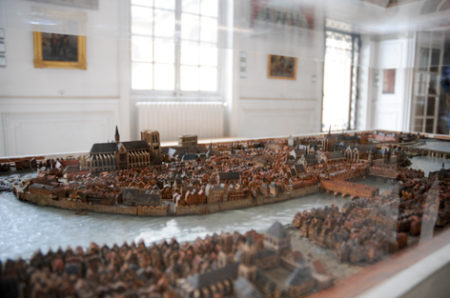
The east side of the island was occupied by the church and it’s various interests. This included the Ancien Cloitre or Ancient Cloister. During the Middle Ages, the eastern section of the Île de la Cité was walled off. Ordinary people could access the church through the three entrances (i.e., main doors or portals) on the western face of the cathedral but that was it. This walled off area was a small city known as Cloître Notre-Dame (Cloisters of Notre-Dame) or Cloître City (my term).
Cloître City
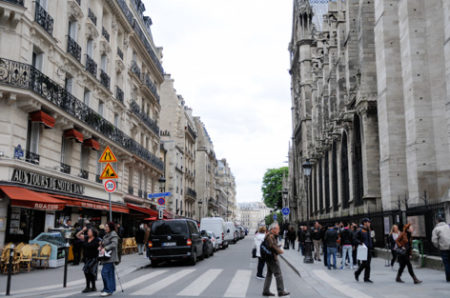
Imagine standing in front of Notre-Dame. To the left (or the north side of the church) would have been one of the four gates allowing entrance to Cloître City. The gates were closed at sunset and re-opened at daybreak. Outsiders (including women) were not allowed in unless invited by an authorized person. The police and the king had no jurisdiction in this area and taxation was forbidden. The inhabitants of Cloître City included the clergy, canons, scholars, church seminary students, and others associated with the church. This area was dominated by the Chanoine monks dating to 911. Cloître City buildings were simple and very similar to normal citizens’ homes. This was in contrast to the opulent residences located on the south side of the church where the Bishop’s Palace once stood (that area today is known as Square Jean XXIII). My fascination with Cloître City is with its various streets.
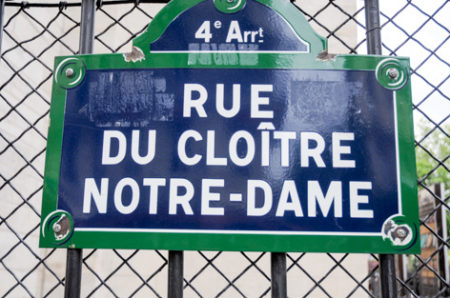
Gargoyles and Chimera

As you move about Cloître City, you will see the famous gargoyles of Notre-Dame. It’s hard to tell but some of what you think are gargoyles are really chimeras. Gargoyles serve a practical purpose—they are a critical part of the rooftop irrigation system in Gothic structures. In other words, they divert the water away from the cathedral. Yes, they are ugly, but no more so than the chimeras. The chimera is a monster from Greek mythology that breathes fires and has a lion’s head, a goat’s body, and a snake’s tail. It is an imaginary monster compounded by incongruous parts and exists only in our imagination. Well, the chimera does exist—at least on the Notre-Dame cathedral. They sit up high looking down on you. What is their purpose? I don’t know but it may be as simple as being decorative.
Cloître City Streets
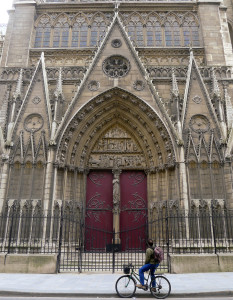
On your way to Rue Massillon, you’ll walk down Rue du Cloître Notre-Dame (along the north side of the cathedral). On your left at 18, rue du Cloître Notre-Dame is a narrow alleyway. This was the main entrance to the Monastery of Our Lady and dates to 1260. Opposite 8, rue du Cloître Notre-Dame is a set of small red doors. Built in 1257, this is the entrance (considered the fourth portal, la Porte Rouge, to the church) used by the clergy, canons, and choir. Right about this area is a great place to look up and see the multitude of gargoyles.
Rue Massillon runs into Rue Chanoinesse where the National Police Motorcycle Brigade is located (18-20, rue Chanoinesse). It was on this site that the Dagobert Tower once stood. Constructed in the 15th-century, it was likely a guard or light tower overlooking Paris’s first port, Saint-Landry. Contemporary paintings reflect this tower with an iron arm that stuck out—presumably to hang a lantern. Although the tower was demolished in 1910, its interior winding staircase was saved and can be seen today at the Cluny Museum (the museum of Paris’s medieval history). During the Middle Ages this site was home to a couple of serial killers.
These are just a few of the stops in Cloître City you will experience in the new medieval books (Cloître City is presented as a stop in Volume Two).
The Parisian Sweeny Todd
You’ve heard the story (and musical) of Sweeny Todd, haven’t you? He was a London barber and serial murderer. Well, the story may have originated in Paris. It was here on Rue Chanoinesse between 1384 and 1387 that a barber and a baker had their storefronts side-by-side. They also shared a basement. At that time, the Rue Chanoinesse was well known for its bakeries and their scrumptious pâtés and meat pies. The barber’s customers included many students, and from time to time, he murdered the unlucky ones. The body was dumped through a trap door into the basement at which point the baker ground up the body and made some of the tastiest pâtés and meat pies in Paris. Even King Charles VI was said to be a fan of the baker’s wares. The last victim, a German student, had a dog that wouldn’t stop howling outside the barber’s shop while waiting for its master. This led the police to the duo, and confessions were extracted from each of them. They were put into an iron cage and burned alive on the Place de Grève. The building was demolished, and the site remained vacant until King François I gave his permission to allow a new structure to be constructed on the site. All of this happened at 18-20, rue Chanoinesse—the same site as the former Dagobert Tower and today’s police motorcycle garage. If you can get into the garage, you can see one of the charred and darkened stone foundations of the original building.
Bon appétit!
Modern Day Cloître City
There are many other stories—too many—to include in this blog. Cloître City is one of the most interesting sections to walk around in Paris. Today, the buildings surrounding you are no older than the 17th-century. The only medieval structures on the island that survived Haussmann’s project were parts of the old palace, the Conciergerie, Saint-Chappelle, and Notre-Dame. Haussmann tore down the old buildings, opened up the island, and created what we see today. However, many of the old streets survived because the politicians stopped Haussmann just in time.
Someone Is Commenting On Our Blogs
I’d like to thank Jodie F. for his comment on how we’re “digging into some interesting history.” Jodie read our last blog (Flowers, Birds, a Jewish Community, and a Murder). I’m always telling Sandy that the research part of writing the walking tour books is the best part of my journey. It’s fun to discover stories that, like Jodie says, are interesting. In fact, some of the stories are hard to believe and I have to tell people that I don’t make this stuff up. One of the most interesting “finds” has been the correlation between the Harry Potter books and medieval terms and legends (e.g., Nicolas Flamel). Keep your comments coming. I love hearing from you.
We Need Your Help
Please tell your friends about our blog site and encourage them to visit and subscribe. Sandy and I are trying to increase our audience and we need your help through your friends and social media followers.
What’s New With Sandy and Stew?
We have worked with some extremely talented people to come up with our new logo. It was necessary to brand Stew Ross, the author as opposed to the corporate entity, Yooper Publications. I hope you like the Stew Ross Discovers™ logo:
We’ve also tried to refine our tag line to more accurately reflect our product:
WALKS THROUGH HISTORY
As part of this refreshing process, we will be working on our blog site to ensure it is updated, professional, easy to navigate, and contain relevant content.
We have a lot of stories and we’re looking forward to sharing these with you. Please continue to visit our blog site and perhaps you’d like to subscribe so that you don’t miss out on our blog posts, past and current.
Thank You
Sandy and I appreciate you visiting with us. We have some exciting things on the horizon and we’ll keep you updated as we go along.
Share This:
Follow Stew:
Find Stew’s books on Amazon and iBooks.
Please note that we do not and will not take compensation from individuals or companies mentioned or promoted in the blogs.
Walks Through History
Copyright © 2016 Stew Ross

